Constituting an essential part of an ethnic community, mother language is a carrier of values and knowledge, very often used in the practice and transmission of intangible cultural heritage. The spoken word in mother language is important in the enactment and transmission of virtually all intangible heritage, especially in oral traditions and expressions, songs and most rituals. Using their mother tongue, bearers of specific traditions often use highly specialized sets of terms and expressions, which reveal the intrinsic depth oneness between mother tongue and the intangible cultural heritage. Below you will find a few selection of practices dealing closely with mother languages.

© Center for Safeguarding ICH of Heilongjiang Province, China, 2010
Hezhen Yimakan storytelling
Inscribed in 2011 on the List of Intangible Cultural Heritage in Need of Urgent Safeguarding
Narrated in the language of the Hezhen people of north-east China, and taking both verse and prose forms, Yimakan storytelling consists of many independent episodes depicting tribal alliances and battles, including the defeat of monsters and invaders by Hezhen heroes. Yimakan performers improvise stories without instrumental accompaniment, alternating between singing and speaking, and make use of different melodies to represent different characters and plots. Yimakan plays a key role in preserving the Hezhen mother tongue, religion, beliefs, folklore and customs. Read more…
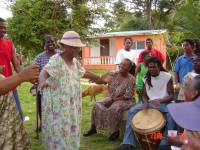
© National Garifuna Council
Language, dance and music of the Garifuna
Inscribed in 2008 on the Representative List of the Intangible Cultural Heritage of Humanity
A population of mixed origin incorporating cultural elements of indigenous Caribbean and African groups, the Garifuna settled along the Atlantic coast of Central America after being forced to flee from the Caribbean island of Saint Vincent in the eighteenth century. Today, Garifuna communities mainly live in Honduras, Guatemala, Nicaragua and Belize. The Garifuna language belongs to the Arawakan group of languages and has survived centuries of discrimination and linguistic domination. It is rich in tales (úraga) originally recited during wakes or large gatherings.The melodies bring together African and Amerindian elements, and the texts are a veritable repository of the history and traditional knowledge of the Garifuna, such as cassava-growing, fishing, canoe-building and the construction of baked mud houses. T here is also a considerable amount of satire in these songs, which are accompanied by various drums and dances, which the spectators may join in. These traditions are still very important to the life and survival of the Garifuna people. The elders are the ones who maintain many of the ceremonies, festivals and oral traditions. However, economic migration, discrimination and the complete absence of the Garifuna language from the school system are endangering its survival. Although the language is still widely spoken, it is now taught in only one village. Read more…
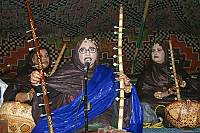
© DPC-Ministère mauritanien de la culture
Moorish epic T’heydinn
Inscribed in 2011 on the List of Intangible Cultural Heritage in Need of Urgent Safeguarding
The T’heydinn epic encompasses dozens of poems in the Hassaniya language lauding the glorious feats of Moorish emirs and sultans and preserving the collective memory of society. Sung by griots and accompanied by traditional stringed instruments such as the lute, harp and kettledrum, the poems are passed down from father to son, with young griots first learning the instrumental skills before being initiated into the poetic tradition. Performances are occasions for regional tribal and family reunions, strengthening social ties and promoting social peace and mutual assistance. Read more…
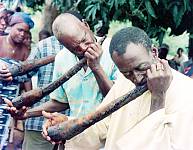
© Angéline Yegnan / UNESCO
Gbofe of Afounkaha, the music of the transverse trumps of the Tagbana community
Inscribed in 2008 on the Representative List of the Intangible Cultural Heritage of Humanity
The Gbofe is mainly performed in the village of Afounkaha in the Tagbana community. The term Gbofe is used both for the transverse horns and for the performance as a whole, which encompasses music, song and dance. The Gbofe horns are made of roots covered by cowhide. Six of these horns are used together, ranging in length from 50 to 70 centimetres. They emit a range of sounds “reproducing” the words of the Tagbana language. These words are then “translated“ by female choirs. The music of the horns and the singing are accompanied by drummers who beat time and give the Gbofe its structure. The Gbofe is played at rituals and traditional ceremonies, and the messages conveyed vary according to the circumstances: praise, love, satire, mourning, moral or educational messages. The Gbofe played an important role by conferring respect towards the holders of the tradition, and by conveying a sense of identity on the communities. The various Gbofe performers follow an apprenticeship. While the know-how is most often passed down from father to son, young talents can also join in the training sessions.
The practice of Gbofe has ceased to exist in various regions of Côte d’Ivoire due to war, rural exodus and industrialization. Although it has been reintroduced in some communities, it is today in danger of disappearing. The young are less and less aware of this tradition.This is leading to a considerable reduction in the number of people who possess the knowledge of the rituals and the skills to make the instruments, along with a similar decline in the number of those mastering the art and techniques of the dance, songs and music. Read more…
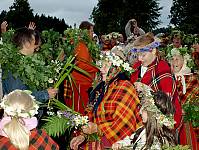
© 2008 by Juris Lipsnis
Suiti cultural space
Inscribed in 2009 on the List of Intangible Cultural Heritage in Need of Urgent Safeguarding
The Suiti are a small Catholic community in the Protestant (Lutheran) western part of Latvia. The Suiti cultural space is characterized by a number of distinct features, including vocal drone singing performed by Suiti women, wedding traditions, colourful traditional costumes, the Suiti language, local cuisine, religious traditions, celebrations of the annual cycle, and a remarkable number of folk songs, dances and melodies recorded in this community. Older forms of extended family structures are still common here, and such families, where the transfer of skills from generation to generation takes place, are important bastions of Suiti cultural heritage. The synthesis of pre-Christian traditions and religious rituals has created a unique blend of intangible cultural heritage in the Suiti community. The pillar of Suiti identity – the Catholic Church – successfully recovered following the Soviet period and as a result, the Suiti cultural space has experienced a gradual renaissance. However, today only a few, mostly old people, have a good knowledge of Suiti cultural heritage, and thus there is an urgent need to disseminate this knowledge and to involve more people in its preservation by recovering elements preserved only in written documents, film archives and museum depositaries. Read more…
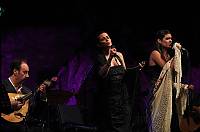
© 6149 Mário Pacheco, Lina Rodrigues e Cuca Roseta 2009 by José Frade
Fado, urban popular song of Portugal
Inscribed in 2011 on the Representative List of the Intangible Cultural Heritage of Humanity
A symbol of identity, Fado music is widely sung in Lisbon and represents a distinctly Portuguese multicultural synthesis of Afro-Brazilian music, local genres of song and dance, rural music, and urban song patterns of the early nineteenth century. Fado is typically performed by a solo male or female singer, accompanied by an acoustic guitar and the Portuguese “guitarra”, a pear-shaped twelve-stringed cittern. It is performed professionally and informally in grass-root associations and often transmitted over successive generations within the same families. Read more…